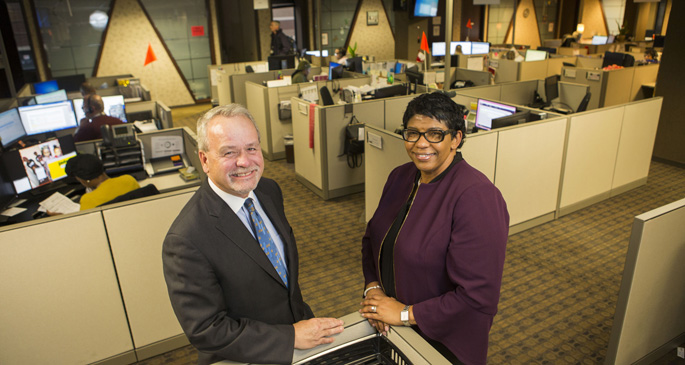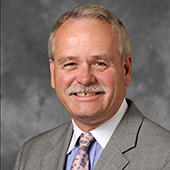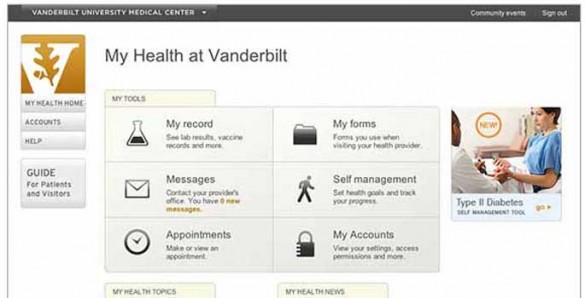
by Jill Clendening
Vanderbilt University Medical Center (VUMC) has stellar health care providers, but if patients can’t get appointments to see those providers in a timely manner, that doesn’t mean much. Fortunately, a Patient Access Services (PAS) team has been working behind the scenes throughout 2018 to knock down barriers to accessing care.
After consulting Patient Care Centers to identify issues hindering timely access to care, the PAS team has tallied a long list of wins that are resulting in shorter wait times for appointments and better access experiences for patients overall, according Lisa Griffin, MBA, CCCM, Vice President of Patient Access Services.
“Access to care is absolutely the lifeblood of our clinical enterprise,” said Thomas Nantais, MBA, Executive Vice President of Adult Ambulatory Operations. “It made sense for us to hone in on areas where we could improve patient access fairly soon after we had eStar, our new electronic medical record (EMR) system, operational. Lisa and her team have been methodically tackling issues, clinic by clinic, so we are able to more consistently provide the responsiveness rightfully demanded by our patients and the referring provider community.”
“Our vision is that we have a patient-centered scheduling model that aligns the patient with the right provider at the right location the first time,” Griffin said. “Our colleagues approach patient access with incredible enthusiasm. We’ve harnessed their motivation to learn where and how we can make systematic and procedural changes to support our shared commitment to patient-centered, barrier-free access. Early results have been positive, and we have the momentum to truly redefine and enhance the patient access experience for everyone, including our providers.”
Three hundred employees now make up the Patient Access Center, with 270 of those employed in Care Connections, the centralized front-line contact center located in Green Hills. There, employees have received updated training on the best way to handle calls, with a process standardized for all clinics throughout the Medical Center.
A Referral Management Center, a separate unit within Care Connections, now manages all internal and external patient referrals in one location. The Referral Management Center also serves as a think-tank/test environment for new processes and technology, Griffin said.
“Our current staffing for Care Connections is based on assuring we meet or exceed our expressed service levels for each of our work streams,” Griffin said. “For example, our service level is to aim to answer 80 percent of our incoming calls in 30 seconds or less. Our outbound call production aims to achieve daily outflow greater than inflow for the referral orders and appointment requests that drive these outbound calls.”
In addition to having well-trained staff answering calls quickly to get patients scheduled for appointments, another significant win is the addition of Wait List, one of many new features in My Health at Vanderbilt.
Wait List allows patients to get on a waiting list for upcoming appointments. If an earlier appointment becomes available patients receive a notification so they can choose to either accept the earlier appointment or keep their existing appointment. About 15 percent of patients using My Health at Vanderbilt are already making use of Wait List.
Another My Health at Vanderbilt enhancement is online scheduling, which allows established patients to easily schedule return visits with their clinicians. Clinicians are also able to benefit from the new functionality through schedules with fewer gaps and no-show appointments.
“We tested the online scheduling system with a pilot with Women’s Health and made needed adjustments,” Griffin said. “Then we executed a fairly rapid roll-out of online scheduling for nearly all other clinical areas, with the current exception of Vanderbilt Ingram Cancer Center where patients often benefit from direct interaction with clinical staff.”
Training is a critical factor in improving patient access and ensuring consistency, so a PAS Learning Lab has been created that provides real-time performance monitoring, training for new PAS employees and a change management lab that can provide quick training for employees when system and protocol changes are made.
“In the future, we’re also planning additional clinician engagement through New Clinician Orientation and an upcoming continuing medical education (CME) course,” Nantais said.
“We’ve learned that extending technical knowledge of our access systems to clinical partners strengthens our ability to review and respond to system issues that might otherwise be masked as personnel, behavioral or training errors. Also, we’re planning to improve our coordination with clinic front desk operations and revenue cycle workflows in order to further enhance the value and reach of Patient Access Services within the organization.”















